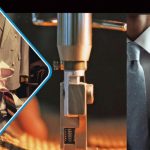A recent case in point is “Sewbot” – a robotic sewing system – from Atlanta-based company SoftWear Automation. The system can cut and sew the soft fabric automatically. The machines use a combination of cameras and needles to track the placement of a fabric before sewing the apparel. In fact, a Chinese firm (Tianyuan Garments) is setting up a factory in the US (in Arkansas) with 21 Sewbot production lines for producing 800,000 T-shirts a day for Adidas. SoftWear’s fully automated Sewbot roughly takes four minutes from fabric cutting and sewing to finished product. The system is scheduled to be fully operational by the end of next year. With all the production lines in operation and complete automation, Tianyuan Garments estimates to make one T-shirt every 22 seconds @ a labor cost of just 33 cents for each T-shirt. A cost so low that no country in the world can compete with.
At present, SoftWear Automation is taking pre-orders for fully automated worklines for t-shirts, and workcells for hemming & binding. Future products include: Jeans & pants, pillows, bath mats, automotive mats, mattresses, towels and tote bags. Tianyuan Garments Company’s facility in Arkansas (USA) will perhaps be the first true example of Industry 4.0 in the textile and clothing sector. So far, the sector was enjoying fruits of automation technology in every sphere except sewing. This is a classic example of how an Industry 4.0 ready technology can disrupt the $100 billion sewn products industry by creating autonomous sewn good worklines for apparel, home goods and footwear with additional benefits of higher quality and lower cost.
However, the key barriers include: data security issues, less human oversight, loss of human jobs, technical problems that can cause expensive production outages. In the Indian context, it is difficult to visualize how things might shape up with respect to Industry 4.0 which calls for more and more automation at each stage, and also more frequent upgrading than we are all accustomed to. There is a general reluctance to spend heavily in new technologies. Also, the possibility of the resultant job losses needs to be carefully looked into. However, it may appeal to a number of big corporates, and also to entrepreneurs who prefer to work with limited labor, to explore the opportunities offered by Industry 4.0 – the symbol of flexibility, adaptability and efficiency.
G.D. JASUJA
Managing Editor





